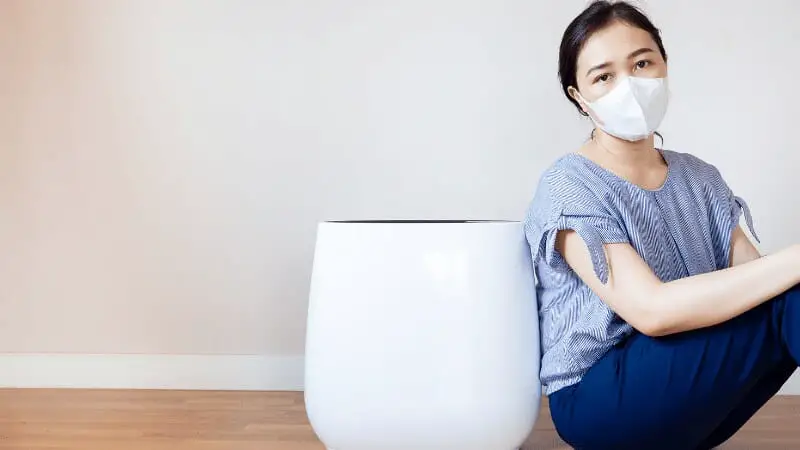An air purifier isn’t the easiest home cleaning and sanitation product to choose.
Often, the buyer has to decide on numerous types of complicated filters, contrasting models, and many equally popular brands.
This guide will expound on the most basic factors you need to bear in mind if you want to choose a product that works for you
The Five Manufactured Home Air Purifier Shopping Factors
Here are the factors:
- The cost of replacing the filters
- Certifications
- Size of the Room
- Noise Production
- Type of Filter
1. The cost of replacing the filters
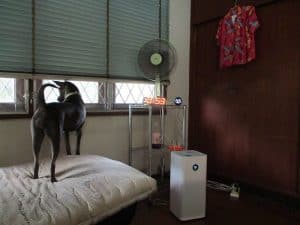
The filter is probably the most critical part of an air purifier.
Because it’s normally the first part to wear out, you need to factor in the replacement cost when purchasing a new product.
Generally, you should replace your filters (or at least clean if they allow) every 6 to 12 months – this is for pleated filters.
For those made from activated carbon, do so once every 3 months.
Read the manufacturer’s guidelines regarding replacement or washing. Most air purifiers nowadays are equipped with an indicator that informs you when to clean or change the filter.
The cost of a new filter can vary widely depending on the type and even the brand.
Filters used by large air purifiers have their price tags somewhere between $20 and $200 a pop. Those equipped with odor-removing carbon often cost $50 or more.
2. Certifications
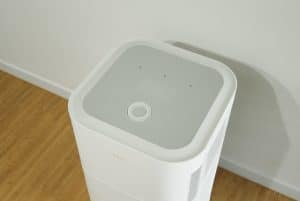
If you didn’t know, there are a few labels you should look for on every air purifier unit of your liking.
The first and most important is the logo of Energy Star.
To be effective, air purifiers need to run around the clock, so you should consider the energy cost of running the product for that long.
EnergyStar certified units are about 40% more energy-efficient compared to the standard unrated models.
You might also see the blue AHAM Verified seal. This label means that AHAM (Association of Home Appliances Manufacturers) has subjected the model to its own testing
. Although this testing is purely voluntary, many brands allow the association to certify their air purifiers through AHAM’s certification program.
The program provides CADRs (clean air delivery rate) and guidelines regarding room sizes – all these will be written on the label.
But, what exactly does CADR tell about an air purifier? It is a rate that reflects – often in cubic feet/minute – the total volume of clean pathogen-free air that the air purifier makes at the highest speed settings possible.
For instance, if a purifier is rated CADR 200 for dust and smoke particles, it means it reduces the level of these particles to the same concentrations that would be met by adding about 200 cubic feet of fresh clean air every minute.
Always go for a product with a higher CADR rating because it means the unit is more efficient and does the job faster.
You will notice that portable air purifiers equipped with HEPA filters also come with the highest CADR ratings.
- Pretty every air purifier review out there gives products with CADR rating over 240 gets an Excellent rating;
- those between 240 to 180 gets Very Good;
- those between 179 to 120 gets Good;
- those between 119 to 60 gets Fair;
- anything below 60 often gets a Poor rating.
It is worth noting that different particles require different CADR ratings – CADR ratings for smoke, for example, won’t work perfectly for pollen or tobacco pollutants.
With that said, focus on the right CADR for your specific pollutant.
For example, a home with a heavy smoker who loves to use the fireplace often would require an air purifier with a higher CADR rating perfect for tobacco smoke.
3. Size of the Room
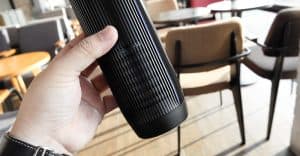
A small air purifier certainly won’t work for a large family room.
Also, if a product has the AHAM Verified seal, it is likely to comfortably handle the suggested size of the room listed on the package.
You can trust the suggestions on the label but don’t be carried away by the claims made by the manufacturers.
Go through a few reviews and you’ll learn that some air purifiers aren’t suitable for their purported room sizes.
Consumerreports.org keeps a list of most of the popular air purifiers out there complete with their ratings and appropriate room-sizes.
You can also choose to size up.
A big part of the models rated for large rooms (often 350 square feet or more) still work perfectly at lower and quieter speeds, which can be great if you are sleeping or watching TV.
4. Noise Production
Judge the air purifier of your liking not just on its performance but also based on how well you will be able to live with it.
Remember that there are times you will leave the machine running for extended periods, so ideally it should run quietly the whole time.
Fortunately, most machines nowadays come with noise ratings printed on them.
Generally, a noise rating in the region of 50 decibels is very much close to your wheezing refrigerator which isn’t bad for an air purifier, or is it?
If you don’t find specific noise ratings on the product’s package, try to visit the brand’s website.
Alternatively, check consumerreports.org list of popular air purifiers with their noise ratings here: these ratings were made both at low speed and high-speed settings.
Other tips for cutting on noise in an air purifier include running the unit on the highest setting when you are not in the space and turning it low when you are nearby. Also, you can purchase products certified for large rooms so that it filters more volumes of air even at low speeds.
5. Type of Filter
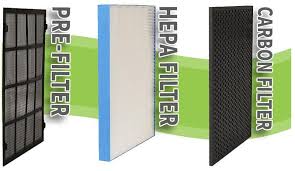
We said the filter is the most integral part of any air purifier, so there’s a lot to talk about.
There are 8 types of filters – we need a full post to shed light on each of them in and out. For now, we’ll take a glance at their most basic details.
Different filters target different particles or forms of air pollution. What they target relies almost entirely on the kind of filtration technology.
The HEPA filter is the most common of all and is perfect for eliminating most of the household allergens like dust, pollen, animal dander, pollen, and particles.
However, they aren’t particularly very good at trapping ultra-fine particles such as viruses, organic compounds, smoke, eliminating foul odors, or chemical fumes.
Since different technologies have different weaknesses and strengths, most modern air purifiers come with multiple media types or multiple filters in one unit.
Regardless of the type of filter media in a product, always look for a mention of something like “sealed system.” The best filter on the planet is literally useless if the system leaks air and permits dirty and purified to mix freely.
With that said, let us look at the Eight types of filters:
HEPA Filter

HEPA (or Higher Efficiency Particulate Air) Filter sets the standards for air purification.
A typical HEPA filter eliminates at least 99.97 percent of all particles, some as small as tiny as 0.3 microns thick.
Allergens such as mold spores, dust, pollen, and animal dander are trapped in this filter.
Perhaps the biggest drawback of HEPA filters is their periodical replacement, which is often frequent.
The main advantage, however, is if you see HEPA certification on an air purifier, you know it will eliminate virtually all common particles in your home.
But note that all HEPA filters aren’t created equal. Size is a factor to consider: the greater the square footage a HEPA filter is designed for, the more particulate matter it will eliminate.
Besides size, the material of construction and the design of the filter media itself too can affect the overall performance of an air purifier and may also explain why one HEPA product is costlier than another.
Almost all popular brands offer one or a few models with HEPA filters, they include
Activated Carbon Filter
This type of filter is rarely installed alone.
Most air purifiers that feature it combine it with one or several other filters.
Activated charcoal/carbon filter excels at eliminating odors and gases and neutralizing such particles as smoke, fumes, and chemicals. When carbon is exposed to oxygen, it creates millions of pores.
These tiny fissures and pores are so many that 1 lb. of activated carbon comes with an incredible 60 – 150 acres of surface area!
This enormous surface area makes carbon perfect for adsorbing odors and gases and providing an expansive surface area for possible bonding with vapor/chemical molecules.
Even more encouraging: the larger your carbon filter is, the more chemical elements it will absorb and also the longer it will last.
When it is full, or when it can no longer absorb more chemical molecules, you have to replace it.
Impregnated carbon filters normally come with an extra chemical (or a “chemisorbant”), that either broadens the variety of chemical molecules the carbon filter will trap or permits for more targeted removal of a particular family or type of chemicals.
Ion Generators & Ozone Generators

These filters create charged particles (or ions) and release them into the air.
These ions cling to impurities such as dust present in the air, causing them to stick to nearby surfaces.
Consequently, ion generators tend to add dirty spots on floors and walls because they don’t eliminate impurities; ion generators function by simply forcing impurities to find a surface and stick there.
Not long ago, ion generators were the second most often used filters in air purifiers.
Now, they are a rare sight on store shelves because they emit ozone gas, a lung irritant that can upset people with asthma and similar lung diseases, the elderly, and small children.
The mere fact that they discolor your walls makes them unattractive to most buyers.
However, some people still use them in their “ozone shock” rooms because they are highly effective at killing mold and pathogens.
Charged Media Filters

These filters combine 2 technologies:
- a mild electrostatic charge
- and a particle filter (very much similar but not close to being as efficient as the HEPA filter).
The charge in these filters works in the same way a static charge causes your socks or shirt to stick together when you remove them from a dryer.
The biggest benefit of buying a charged filter is that it can round up tiny small particles, sometimes 0.1 microns or smaller.
The drawback, however, is that, just like their electrostatic precipitator counterparts, they run out of their efficiency quite fast. They actually require far more frequent replacements than HEPA filters.
Some of the 3M’s Filtrete family of air purifiers comes with this filter technology.
There is a slight variation of this technology, which uses a tiny metal filament that permits electrical current to flow in it and charge the particles.
The charged ions will attract the particles and cling with them. This technology does produce ozone although the air purifiers with it don’t.
Blueair supplies some of the best products in this class (no ozone).
Charged media filters and their versions are known to produce filtration rates that SURPASS HEPA standards. They are some of the best for whole-house applications.
Electrostatic Precipitators
This type of filter employs a similar principle to charged media filters except that the charged particles are precipitated out and allowed to adhere on collector plates instead of being captured on filters straightaway.
There are two major problems with this filtration technology:
- Firstly, airflow is very critical, and if it isn’t robust enough, the system will simply recycle the same air repeatedly.
- Secondly, cheaper and older versions of this type of filter actually emit ozone contrary to what consumers have been told all long.
The big advantages, however, are that the product’s collector plates don’t have to be replaced at all; just wash them in your dishwasher and they’ll be able to start all over again.
Air purifiers with these filters also tend to be very quiet. At the moment, however, these models are starting to disappear on the market.
Antibacterial & Germicidal Filters

If you are looking for the best air purifier designed specifically to eliminate germs and bacteria in the air, choose a product with this filtration technology.
The best starters for you can be AirPura UV600 and Germ Guardian AC5000.
Some products use a UV lamp to kill germs. If you choose one with a 20W UV bulb, you can be sure it is CARB certified (California Air Resources Board certification) and kills germs, pathogens, and most microbes.
CARB certification actually means the product won’t create ozone.
These filters are rarely used in air purifiers intended for homes because of their fixation on eliminating pathogens.
You will mostly find them in daycares, hospitals, kitchens, and laboratories. Those used in residential areas are mainly aimed at controlling mold.
Sickly homeowners whose immune systems need to be taken care of more closely prefer air purifiers with these filters.
Photocatalytic Oxidation (PCO)

PCO is a new filtration technology that you probably haven’t heard about yet.
There are 2 components in this filter:
- a source of UV light
- and a titanium oxide plate.
This technology is highly effective in oxidizing most VOCs (Volatile Organic Compounds).
Pre-Filters

These filters are designed to remove pet hair, filaments that pull off your carpet fabrics, and other large filamentous particles.
They will remove these particles before actual filtration and can be found alongside all aforementioned filters in pretty all types of air purifiers.
Some of these pre-filters are foamy or consist of non-woven polyesters, while some feature electrostatic properties to boost filtration.
It is recommended that you choose pre-filters made of activated carbon – they will trap large filamentous particles and adsorb smoke and odors on top of everything.
Regularly changing your pre-filters will boost their life span.
Related: Can You Run an Air Purifier and Ceiling Fan at The Same Time?
Conclusion
An air purifier removes contaminants from room air to improve the overall air quality. It is no longer a product for asthmatics and allergy sufferers but anyone keen to improve air quality in their living or working space.
The filter is probably the most critical part of an air purifier. Because it’s normally the first part to wear out, you need to factor in the replacement cost when purchasing a new product.
Generally, you should replace your filters (or at least clean if they allow) every 6 to 12 months – this is for pleated filters. For those made from activated carbon, do so once every 3 months.
Read the manufacturer’s guidelines regarding replacement or washing. Also, there are about 9 types of filters – choose one that fits your needs.
It is worth noting that different particles require different CADR ratings – CADR ratings for smoke, for example, won’t work perfectly for pollen or tobacco pollutants. With that said, focus on the right CADR for your specific pollutant.
A small air purifier certainly won’t work for a large family room. Also, if a product has the AHAM Verified seal, it is likely to comfortably handle the suggested size of the room listed on the package.

